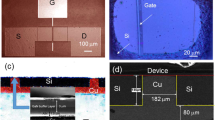Abstract
Low-dose high-energy ion implantation is effective for isolating GaN high-electron-mobility transistors (HEMTs). However, lateral penetration of implanted ions induces damages at sides of AlGaN/AlN/GaN HEMTs and causes parasitic channel formation. By comparing ion implantation isolated HEMTs with varied widths, the parasitic channel behavior is characterized: the parasitic channel shows low on-state conductance, reduced gate current, and more positive threshold voltage compared to the active HEMT channel. The high N ion implantation energy for HEMT isolation was up to 375 keV, and the effective widths of HEMTs are narrowed by ~ 0.5 µm. The electrical characteristics of the parasitic channel are theoretically understood by considering ionization of point defect generated in the AlGaN/AlN/GaN heterostructures.
Graphical abstract





Similar content being viewed by others
Data availability
The datasets generated during and/or analyzed during the current study are available from the corresponding author on reasonable request.
References
S.J. Pearton, C.B. Vartuli, J.C. Zolper, C. Yuan, R.A. Stall, Ion implantation doping and isolation of GaN. Appl. Phys. Lett. 67, 1435 (1995). https://doi.org/10.1063/1.114518
S.O. Kucheyev, J.S. Williams, J. Zou, C. Jagadish, G. Li, Ion implantation into GaN. Mater. Sci. Eng. R 33, 51–107 (2001). https://doi.org/10.1016/S0168-583X(00)00672-8
A.N. Tallarico et al., Gate reliability of p-GaN HEMT with gate metal retraction. IEEE Trans. Electron Devices 66(11), 4829–4835 (2019). https://doi.org/10.1109/TED.2019.2938598
H. Yu et al., Leakage mechanism in ion implantation isolated AlGaN/GaN heterostructures. J. Appl. Phys. (2022). https://doi.org/10.1063/5.0076243
G. Hanington et al., P/He ion implant isolation technology for AlGaN/GaN HFETs. Electron. Lett. 34(2), 193–195 (1998). https://doi.org/10.1049/el:19980091
T. Oishi et al., Highly resistive GaN layers formed by ion implantation of Zn along the c axis. J. Appl. Phys. 94(3), 1662–1666 (2003). https://doi.org/10.1063/1.1590412
J.Y. Shiu et al., Oxygen ion implantation isolation planar process for AlGaN/GaN HEMTs. IEEE Electron Device Lett. 28(6), 476–478 (2007). https://doi.org/10.1109/LED.2007.896904
H. Umeda, T. Takizawa, Y. Anda, T. Ueda, T. Tanaka, High-voltage isolation technique using fe ion implantation for monolithic integration of AlGaN/GaN transistors. IEEE Trans. Electron Devices 60(2), 771–775 (2013). https://doi.org/10.1109/TED.2012.2230264
A. Taube et al., Ion implantation for isolation of AlGaN/GaN HEMTs using C or Al. Phys. Status Solidi A Appl. Mater. Sci. 212(5), 1162–1169 (2015). https://doi.org/10.1002/pssa.201431724
A.Y. Polyakov, S.J. Pearton, P. Frenzer, F. Ren, L. Liu, J. Kim, Radiation effects in GaN materials and devices. J. Mater. Chem. C Mater. 1(5), 877–887 (2013). https://doi.org/10.1039/c2tc00039c
S.R. Challa et al., Understanding high-energy 75-MeV sulfur-ion irradiation-induced degradation in GaN-based heterostructures: the role of the GaN channel layer. IEEE Trans. Electron Devices 68(1), 24–28 (2021). https://doi.org/10.1109/TED.2020.3037259
N.A. Vega et al., Outstanding reliability of heavy-ion-irradiated AlInN/GaN on silicon HFETs. IEEE Trans. Nucl. Sci. 66(12), 2417–2421 (2019). https://doi.org/10.1109/TNS.2019.2954216
G. Sonia et al., Proton and heavy ion irradiation effects on AlGaN/GaN HFET devices. IEEE Trans. Nucl. Sci. 53(6), 3661–3666 (2006). https://doi.org/10.1109/TNS.2006.885006
U. Peralagu et al., CMOS-compatible GaN-based devices on 200mm-Si for RF applications: integration and performance. Int. Electron Devices Meeting IEDM (2019). https://doi.org/10.1109/IEDM19573.2019.8993582
H. Yu et al., Surface state spectrum of AlGaN/AlN/GaN extracted from static equilibrium electrostatics. IEEE Trans. Electron Devices 68(11), 5559–5564 (2021). https://doi.org/10.1109/TED.2021.3115086
B. Parvais et al., Advanced transistors for high frequency applications. ECS Trans. 97(5), 27–38 (2020). https://doi.org/10.1149/09705.0027ecst
J.F. Ziegler, M.D. Ziegler, J.P. Biersack, SRIM—the stopping and range of ions in matter (2010). Nucl. Instrum. Methods Phys. Res. B 268(11–12), 1818–1823 (2010). https://doi.org/10.1016/j.nimb.2010.02.091
H. Yu et al., Thermal budget increased alloy disorder scattering of 2DEG in III-N heterostructures. Appl. Phys. Lett. (2022). https://doi.org/10.1063/5.0093839
K. Lee, M.S. Shur, T.J. Drummond, H. Morkoç, Low field mobility of 2-d electron gas in modulation doped Al xGa1-xAs/GaAs layers. J. Appl. Phys. 54(11), 6432–6438 (1983). https://doi.org/10.1063/1.331922
S. Turuvekere, D.S. Rawal, A. Dasgupta, N. Dasgupta, Evidence of Fowler-Nordheim tunneling in gate leakage current of AlGaN/GaN HEMTs at room temperature. IEEE Trans. Electron Devices. 61(12), 4291–4294 (2014). https://doi.org/10.1109/TED.2014.2361436
Author information
Authors and Affiliations
Corresponding author
Ethics declarations
Conflict of interest
No funds, grants, or other support were received.
Additional information
Publisher's Note
Springer Nature remains neutral with regard to jurisdictional claims in published maps and institutional affiliations.
Rights and permissions
Springer Nature or its licensor (e.g. a society or other partner) holds exclusive rights to this article under a publishing agreement with the author(s) or other rightsholder(s); author self-archiving of the accepted manuscript version of this article is solely governed by the terms of such publishing agreement and applicable law.
About this article
Cite this article
Yu, H., Peralagu, U., Alian, A. et al. Parasitic side channel formation due to ion implantation isolation of GaN HEMT. MRS Advances 7, 1274–1278 (2022). https://doi.org/10.1557/s43580-022-00453-6
Received:
Accepted:
Published:
Issue Date:
DOI: https://doi.org/10.1557/s43580-022-00453-6




